The world of tennis is often defined by moments that resonate deeply with players and fans alike. For Taylor Townsend, her recent victory in the women’s doubles final at the Australian Open marked a poignant return to the scene of her earlier triumphs, symbolizing both personal growth and professional acclaim. Accompanied by her partner Katerina Siniakova, Townsend showcased resilience and cooperative synergy, overcoming the formidable duo of Su-Wei Hsieh and Jelena Ostapenko in an intense three-set battle, concluding with a score of 6-2, 6-7 (4), 6-3.
Townsend’s return to the court where it all began for her was not merely about the physical act of competing; it was about rediscovering a part of herself that she embraced a decade ago. At just 15 years old, she clinched the junior title at the same venue in 2012—a pivotal moment that ignited her aspirations within professional tennis. As she reflected, “This is super special to me,” emphasizing the emotional weight this occasion held. It is vital in the world of high-stakes sports to maintain a sense of personal history because it often molds athletes’ motivation and resilience during tough matches.
Townsend and Siniakova demonstrated the depth of their collaboration as a team. This victory was not their first rodeo; they had previously tasted success together at Wimbledon the year before, also reaching the semifinals at the US Open. Such milestones lay the foundation for team dynamics, ensuring that they could rally under pressure—a skill that proved crucial during the match against Hsieh and Ostapenko.
The contest unfolded dramatically, with Townsend and Siniakova initially seizing a commanding lead. Their powerful on-court chemistry was palpable, evident when they surged ahead to a 6-2, 5-3 advantage. However, momentum swiftly shifted when Hsieh and Ostapenko mounted an impressive comeback, spurred by their third-seeded underdog status. With an unyielding spirit, they equalized and pushed the second set into a tense tiebreaker. This moment is a stark reminder of how crucial mental fortitude is in tennis—having a formidable game plan does not guarantee victory if the competitor’s resolve remains unbroken.
As the match proceeded into the final set, the pressure amplified; each point became a narrative of grit and determination. The defensive lapses that Townsend and Siniakova observed in their opponents’ game became essential to their strategy. Particularly, they capitalized on weakness in Hsieh’s service game, executing key breaks that shifted the rhythm of play. In these climactic moments, their practiced coordination came to light, illustrating how teamwork and tactical awareness can make or break a match.
Success in Grand Slam tournaments carries weighty implications beyond individual accolades. For Siniakova, maintaining her position atop the WTA doubles rankings for an impressive 136 weeks cements her status as a legacy player in the sport. Her experience in high-pressure situations served as a steadfast backbone during the final. This bout at the Australian Open epitomizes not just a victory in a single tournament, but a significant statement regarding their readiness to compete at the highest level consistently.
As they concluded the match with grace and poise, with Siniakova serving out the final game and Townsend sealing it with a decisive point at the net, the triumph served as a culmination of both hard work and the reawakening of tender memories that shaped Townsend’s career.
Looking Ahead
Moving beyond the celebration of this victory, the trajectory ahead for both players remains full of promise. Townsend’s emotional return symbolizes her reconnection with her roots, potentially inspiring a new chapter in her career. As she reflects on this moment that defines her journey, it also opens the door to new opportunities in forthcoming tournaments. For the world of tennis fans, this narrative of resilience, teamwork, and emotional investment reminds us that the sport is not solely about winning or losing; it’s about growth, memory, and the relentless pursuit of one’s dreams.


Leave a Reply